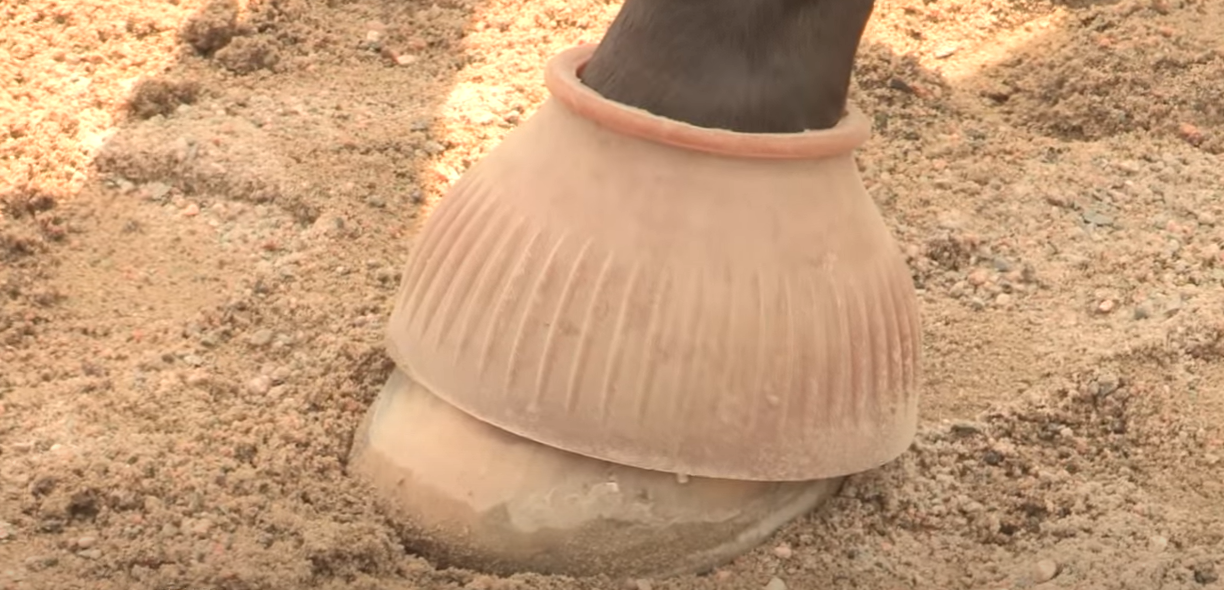Horse boots have been around for a long time and there are many different types. And ultimately, they’ve all be designed to protect your horse's hooves and legs in some way. So in this guide, we’re going to take a deeper look at bell boots. We’ll find out what kind of protection they offer as well as the different types of bell boots. This way, you’ll be well informed when it comes to choosing the best bell boots for horses.
What Are Horse Bell Boots?
Bell boots are also known as overreach boots and they create a protective dome around your horse's foot. Their main function is to protect the bulb of the heel on the front legs, from being damaged from the back hooves.
This damage occurs when horses “overreach”. This means, instead of the back hoof landing in the same place as the front hoof, with overreaching, the back hoof lands slightly ahead of the front hoof. Thus, the horse will clip the heel of the front hoof with the toe of the hind hoof.
This can cause minor grazing or severe wounds and in some cases, overreaching can even pull a front shoe off.
Related: Why Do Horses Need Shoes?
Horses are more at risk of overreaching during fast work. So most horses only need to wear overreach boots for riding. But others might have a permanent overreach and these horses may need to wear bell boots for turnout too.
You can also use bell boots for travel and lunging. But make sure that your horse only wears overreach boots when it needs to, otherwise, it simply gets in the way of a good stride.
Different Types of Bell Boots

Bell boots come in a whole range of different styles and designs to suit every type of horse and riding discipline. So below, we’ll take a look at the most common types of bell boots for horses.
Pull-On
Pull on bell boots for horses are usually made from gum or rubber so they’re tough and durable. With pull-on boots, you have to stretch them over your horse's hooves to get them into place. And this takes some effort but it means that the boot is more secure and has less chance of falling off.
No-Turn
Bell boots are designed so that they can spin around over your horse's foot. But sometimes, no matter what sized bell boot you buy, you might have a problem with it spinning too much. So no-turn bell boots have been designed to keep spinning to a minimum. And they do this via a small nodule that sits between the heel bulbs providing an anchor.
Open
Open bell boots will have some kind of closure, usually, hook and loop. This means that you can open the bell boot up to put it on your horse. Because these boots don’t have to be stretched over your horse's hoof, they can be made from a range of different materials.
Anatomical
Anatomical bell boots have a slightly different design. Instead of being dome-like, they’re more fitted to the shape of the hoof, which makes them more streamlined. Anatomical bell boots often claim to be the most shock-absorbing because they’re usually made from thick durable materials such as leather and neoprene or a mixture of both.
How to Choose the Best Bell Boots for Horses
If you've asked yourself "does my horse need bell boots?" and the answer is yes, then take a look at our helpful buying guide below. Because when it comes to buying bell boots for your horse, there are lots of things to take into consideration.
With bell boots, it’s not a case of one design fits all. You must choose a pair carefully according to your needs. And you should also consider buying a few different pairs if your horse needs them for exercise and turnout.
To help you pick out the perfect bell boots for your horse, below, we’ve listed the most important things you’ll need to consider.
Purpose
First, you need to ask yourself what you’ll be using the boots for. If you’re using them for riding then what discipline are you in? Cross country riders prefer shorter boots so that there’s less risk of them being caught in anything. Whereas show jumpers prefer anatomical or longer bell boots.
If your horse needs bell boots for turn out then you should choose dirt and water-resistant bell boots. These are more durable when your horse is out in the field. For turn out bell boots, it's also better to choose a brighter color in case your horse loses one in the field.
Material
The most common materials for bell boots are gum, rubber, neoprene or leather. Leather bell boots are the most expensive type of boots. This is because of their high durability and they also look professional in the show ring.
Gum and rubber boots are stretchy, durable and easy to maintain and they come in a range of fun, bright colors. Neoprene boots are good because they’re comfortable and shock-resistant. They are usually dark-colored too which makes them good for events and competitions.
Size
Bell boots usually come in very basic sizes. And a size that fits your horse with one manufacturer, might not with another. Sometimes you might have to go through a bit of trial and error to get the best sized bell boots for your horse.
But it’s essential that you only use the correct size boots otherwise they will pose a risk to you and your horse's safety. If the boots are too long and touching the ground, depending on the material, you might be able to trim a bit off the bottom of the boot.
Extra Features
If you struggle to find the right size boot for your horse and you keep finding painful rub marks from the boots, you should choose a pair with extra comfort features. Some bell boots have a soft sheepskin or fleece lining around the top.
If your horse has to wear bell boots for tun out, you should also choose ones with a comfort feature. Because even the most well-fitted ones can cause rubs when your horse wears them for long periods.
And if you have a problem with the boots turning too much, you should choose no turn boots.
Other Helpful Equine Boots
You may also be interested in other types of boots for horses. Be sure to check the following to see which is the right choice for you:
The 7 Best Horse Bell Boots
To give you a head start when it comes to choosing the best overreach boots for your horse, we’ve listed our favorite ones below.
1. Professionals Choice Equine Ballistic Bell Boot
These boots from Professionals Choice are a great boot for trail riding. This is because they’re one of the most durable boots on the market. The outer is made up of a tough “Ballistic” nylon fabric so they can take daily abuse from any riding discipline.
As well as this, they have a special “UltraShock” lining which offers the ultimate in protection and shock absorption. These boots also have a “no turn” knob to prevent them from slipping. And they’re available in 14 unique colors and six different sizes, so you’ll be sure to find the perfect pair.
These Neoprene boots from Horze offer outstanding protection against overreaching injuries. The tear-resistant neoprene will mold to the shape of your horse's leg and hoof over time, giving them a customized fit. These boots are highly shock-absorbing and offer maximum comfort and protection. As well as this, they’re easy to maintain and are available in several striking colors.
These pull-on, rubber bell boots from Intrepid are the best bell boots for turnout. This is because the rubber material can withstand any amount of water, mud and general abuse. These boots come in several bright colors too. So you'll be able to spot one easily in the field if your horse manages to wriggle free of them. And if you do manage to lose one, they’re reasonably priced, so it won't cause too much financial damage.
These boots from Kavallerie have it all when it comes to comfort. They feature a soft rolled lining that prevents rubs and sores. And this works alongside an anti turn feature to keep the boots securely in place. These boots are flexible, durable and shock and water-resistant, and they’re easy to put on and take off. As well as this they’re easy to clean and maintain and they’re available in black.
These classic equine no-turn bell boots are available in 10 vibrant colors and four different sizes. They’re made from a 2520 denier “DynoHyde” nylon material with a shock-absorbing center. These durable boots are water repellent and stain-resistant. And they’re fitted with a single, secure fit, hook and loop closure.
These no-turn bell boots from Weaver Leather come in over 20 different colors and designs. So you’ll be able to find a different style for every event and occasion. They’re made with tough 2520 denier ballistic nylon and they’re lined with shock-absorbing neoprene for extra protection around the coronet. They’re securely fitted by a double-ply hook and loop closure. And these boots are available in three different sizes.
These are a durable and super shock-absorbing pair of open bell boots from Tough 1. They’re made with a double layer of neoprene which provides comfort and promotes airflow. As well as this, these boots are contoured around the heel which keeps them securely in place. And they fasten with a single, secure fastener. They're available in five different colors and three different sizes.
How to Measure for the Right Sized Bell Boot
Bell boots usually come in small, medium and large sizes and you can determine what ones your horse needs by assessing its hoof and legs. But because there are so many different types of bell boots, you should refer to the individual manufactures size guide.
When you put the boot on your horse, it should cover the bulb of the heel. It should be a snug fit and you should just about be able to get your index finger between the top of the boot and your horse's pastern.
The boot shouldn’t move around too much but there should be a bit of room for maneuver. If it’s too loose or too tight then it can cause painful rubs on your horse's pastern and heel. Sometimes bell boots have an anti-spin device and this should be placed between the heel bulbs.
Finally, the boot must have at least a third of an inch of clearance from the ground when the horse is standing on a flat surface. If the boot is too long and touches the ground then this can trip a horse up.
How to Stop Overreach Boots From Rubbing Together?
It’s very easy for overreach boots to rub against each other and your horse's legs if they’re not the right size. So if you’re having a problem with the boots either rubbing together or causing a rub wound on your horse's pastern then you need to try a different sized boot.
Are Overreach Boots Allowed in Dressage?
Your horse can wear overreach boots during dressage training and warm-up, but not during competition. Horses aren’t allowed to use any kind of bandages or leg protection in affiliated dressage competitions. If you turn up in the show ring with your horse wearing overreach boots you’ll more than likely be disqualified from the competition.
Conclusion
Bell boots are perfect for horses who tend to overreach. They’ll save your horse from potentially severe heel injuries and they can also prevent your horse from losing a shoe.
But to get the most out of a pair of bell boots, you must choose ones that are suitable for the job. And by following the advice in this guide, you’ll be sure to pick out only the very best bell boots for horses.











